Rarities
In North Dakota, I always see some things I've never seen before, and some things that are hard to see anywhere else. Nestled in the grass near where we saw both the displaying Sprague's pipit and the Baird's sparrow was a butterfly I was sure I'd never seen. One of the things I love about carring my camera everywhere is that I don't have to frantically scribble down obscure underwing markings and antenna knob color in my notebook. I just try to get the best picture I can and go about my merry way, keying it out when I get to a field guide. This is a Chryxus Arctic, Oeneis chryxus. I'm not sure I've ever seen an Arctic before, much less this one.
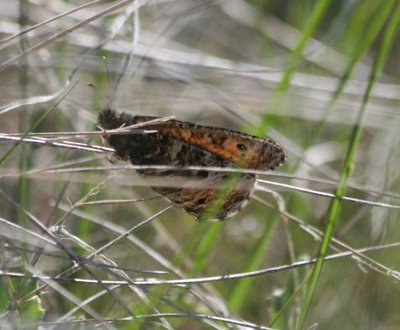 Eastern birders count the American bittern among the rarest of the rare, but in North Dakota it's possible to see them both standing in the reeds by the roadside and in flight.
Eastern birders count the American bittern among the rarest of the rare, but in North Dakota it's possible to see them both standing in the reeds by the roadside and in flight.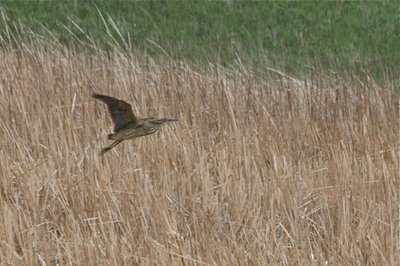 If you look closely at these photos you can see the bittern's impossibly long green toes sticking out behind its tail.
If you look closely at these photos you can see the bittern's impossibly long green toes sticking out behind its tail.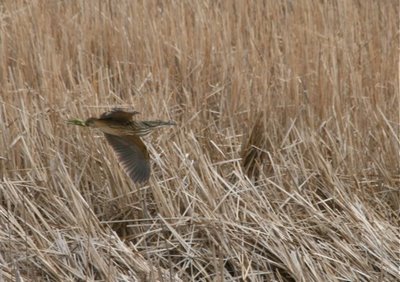 They're kind of Gollumesque birds. This one was being perforated by a red-winged blackbird as it made its way toward a slough.
They're kind of Gollumesque birds. This one was being perforated by a red-winged blackbird as it made its way toward a slough.Something you don't see very much in the East: a bull, walking down a country road toward a battery of birders.
 He was much more interested in some heifers penned in the grove, and turned off before I had to get out my red cape and tri-cornered hat. Tracks showed that he'd been wandering up and down the road for quite some time.
He was much more interested in some heifers penned in the grove, and turned off before I had to get out my red cape and tri-cornered hat. Tracks showed that he'd been wandering up and down the road for quite some time.Abandoned houses are increasingly rare where we live, thanks to people's propensity for simply knocking or burning them down. I love abandoned houses, love to poke around in them and look for signs of the lives they once sheltered. Bill of the Birds is very spooky but he ventured a peek in this one. He has his neck warmer pulled up as a kind of stovepipe hat; it was that cold. Oz never did give nothin' to the Tinman.
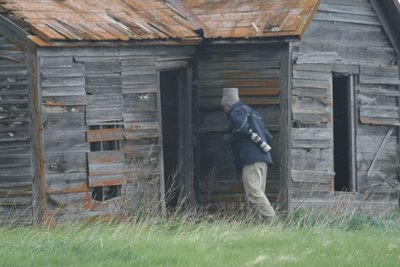
Outside was an old buckboard wagon. I wondered how long all this had stood on the prairie, covered by snow and battered by the incessant wind. It was freezing, even in June, on this drizzly day.
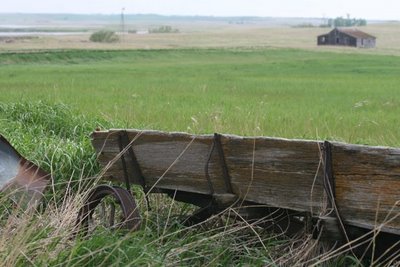 Abandoned buidings are everywhere out here, each one lonelier and more evocative than the last. This one might have been a schoolhouse, with sturdy little blonde kids inside.
Abandoned buidings are everywhere out here, each one lonelier and more evocative than the last. This one might have been a schoolhouse, with sturdy little blonde kids inside.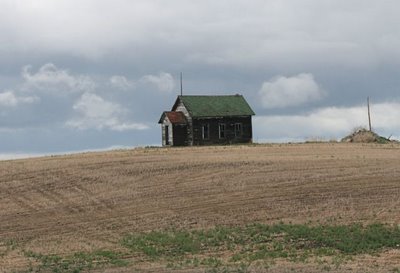 But the rarest of the rare came over the phone as we were birding our way back to Carrington after a long day in Kidder County. Three whooping cranes had been reported from a farm section that was about ten miles from nowhere. We swooped in and spotted them without any problem. It's hard to miss four-foot-high white birds on a muddy field.
But the rarest of the rare came over the phone as we were birding our way back to Carrington after a long day in Kidder County. Three whooping cranes had been reported from a farm section that was about ten miles from nowhere. We swooped in and spotted them without any problem. It's hard to miss four-foot-high white birds on a muddy field.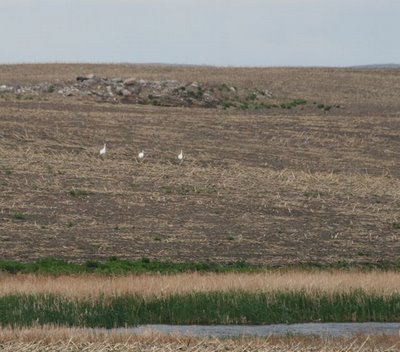 I am not proud of this photo, but we were almost a mile away, and even at that the cranes were nervous about us--walking away. We dared not press them. Because nothing goes unnoticed for long, even in the middle of nowhere, a truck soon rolled up. Inside was a landowner who had been watching over the birds for more than a week. He had been quiet about them, realizing that they were vanishingly rare and worthy of protection.
I am not proud of this photo, but we were almost a mile away, and even at that the cranes were nervous about us--walking away. We dared not press them. Because nothing goes unnoticed for long, even in the middle of nowhere, a truck soon rolled up. Inside was a landowner who had been watching over the birds for more than a week. He had been quiet about them, realizing that they were vanishingly rare and worthy of protection.It was nice to know they'd had a good week's rest, especially when a car with three clued-in birders appeared on the horizon and drove perhaps a half-mile over the prairie directly toward the birds. The birders got out, bristling with scopes and telephoto lenses, and put them to wing, apparently for good. We were too far away to hail them or to do anything more than shake our heads in bewilderment at the intrusion. It was especially embarrassing given that the landowner had been so gracious to us. The cranes weren't seen again. There were a lot of disappointed birders at the festival for whom whooping crane would have been a life bird.
Asking around with USFWS personnel and checking listservs soon revealed that the three birds were one-year-old males that were led south via an ultralight aircraft from their natal area in Wisconsin. According to Tom Stehn, Whooping Crane Coordinator at Aransas NWR, they returned to central Wisconsin this spring just as researchers had hoped, then (naughty birds) took off for North Dakota. These are the things that radios and color bands tell us. If there's a silver lining to this story, it's probably a good thing that the cranes, imprinted as they are on an ultralight aircraft, still retain such a healthy and well-founded suspicion of people. It's tough to be a tall, white bird that everyone wants a piece of. They're the Brangelinas of the bird world, and they don't like the paparazzi, either.
Labels: American bittern, Chryxus Arctic, North Dakota, whooping cranes





